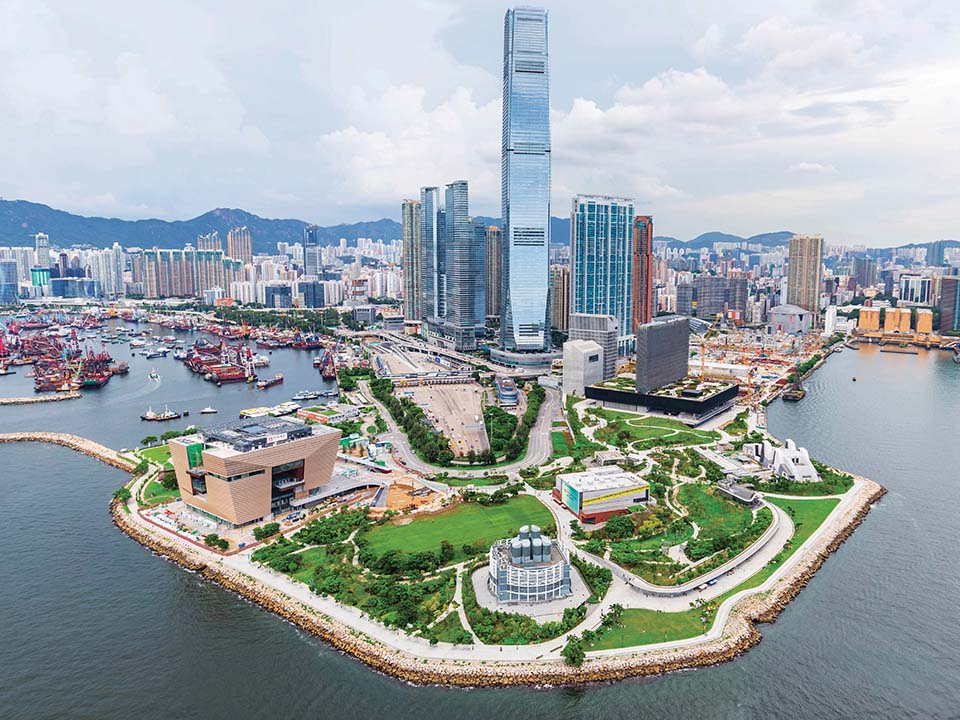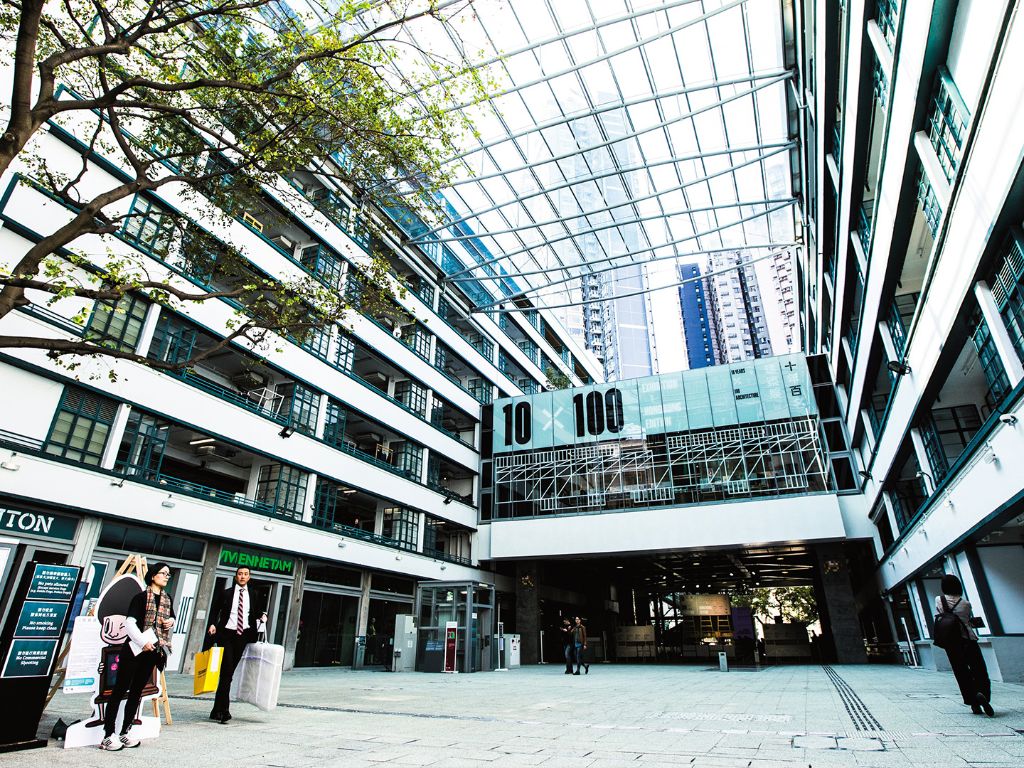Increase of duty-free allowance for luggage articles brought into the Mainland by Mainland residents travelling from Hong Kong takes effect from 1 July 2024. Click here for details.
Train stations are states of transition. Either you are making your first steps into a different place; anticipating the newness of the coming experience. Or you’re lingering while waiting to depart, stuck between the memories of where you’re leaving and the thoughts of the next destination.
If the “different place” is Hong Kong; and your state of transition is the Hong Kong West Kowloon Station, pay attention and you will notice six works of art that will resonate with your experience. Created by artists from Hong Kong, Mainland China and overseas, they are strongly rooted in themes about the city and the experience of travel.

Welcome. Look up!
Arrivals can be the most hurried part of a journey. You’ve passed immigration, walked the corridors, each step bringing you closer to your goal: getting into your destination. When arriving, people look ahead. But in the Arrival Concourse of the West Kowloon Station, you’d be well advised to look up too.
Wrapping (seemingly flowing) around cladding and pillars is the more than 60-metre-long Mountains and Rivers Without End by Wucius Wong (b. 1936). A scholar, teacher, writer and artist, Wong is a legendary figure in the Hong Kong arts scene.
Reminiscent of a classical Chinese landscape, it depicts clouds, lakes, streams, plains, plateaus, mountains, valleys and waterfalls in a scroll that has no beginning and no end. All of the geographical features depicted were created from the artist’s imagination, demonstrating that it is possible to build landscape completely from memory, and highlighting the fact that people construct their own worlds based on their cultural and historical backgrounds.
“This is a city that is ever changing, and the city is formed and re-constructed in the flash of an eye,” says Wong. “It is this issue that creates a cityscape that is part memory and part reality, existing only in the eye of the beholder. My landscape created entirely in my own mind and represented on canvas, lies within this continuum of human experience.”
The continuous, undulating scenery interplays beautifully with the contours of the station while thousands of passengers pass underneath, heading in the direction of the ever-changing city that served as its inspiration. Many of them will pass Exit A on the way to MTR Austin Station, part of the city’s subway system. Along the way, they will encounter another work by a local artist.

Horizons and borders
In his quest to resolve the issue of where exactly Hong Kong’s horizon lies and to definitively map out the city’s border, conceptual artist Tozer Pak (b.1977) painstakingly documented Hong Kong’s boundaries by hiring boats and taking pictures of the exact points where it ‘ends’, visualizing this with a text and 3D mural in the station. Horizon on the Border/Ponder on the Border, presented in two halves in two of the station’s subways, depicts an artificial continuous horizon in the one leading to and from Arrivals; with the horizon line set horizontal in the sloping passage.
In the second part, along the subway leading to and from Departures, Pak recreated maps of all the islands he visited to take photos. Linked by a horizontal line of text, each island is represented in three dimensions, with the contours carefully carved from a solid block of stone.
The artist grappled with the question of where Hong Kong begins and ends. The result, is a work that also serves as a landmark for passengers arriving into the high speed rail station from Austin Station — meeting someone at arrivals? Follow the blue sea horizon. Going to Departures, walk alongside the black stone islands.
But those still coming from Arrivals are about to make their first step into the city, by taking a local subway train or getting a taxi. For visitors opting for the latter, something unexpected awaits.

Element of surprise
After journeys through state-of-the-art transport facilities such as modern train stations and airports, taxi waiting areas tend to be anti-climatic. For arriving passengers, the first sense of the outside is often non-descriptive and boring. But Hong Kong graphic artist Javin Mo (b. 1976) was tasked with making the Taxi Stand of the Hong Kong West Kowloon Station inspiring and fun. And he achieved it with a work called Lost in Neon.
Taking his cue from Hong Kong’s iconic night scenery, which is illuminated with the endless neon of restaurants, night clubs, shops and other businesses, Mo used the colours and forms of the city to create an ebullient and colourful taxi stand.
Regular visitors to the city will recognize the red, blue and green hues as representing the city’s three different taxi colours and the reflection of the neon-like LED tubes and lightboxes on the taxis as they pull up as an iconic Hong Kong visual. Each bay has a “neon” sign based on real advertising signs that have become part of the city’s landscape.
“I wanted my work to introduce visitors to local neon culture and remind locals of the significance of these visuals in Hong Kong, which are so crucial to the city’s landscape,” says Mo.

Panorama of memories
If entering the station from the West Kowloon Cultural District, artistic impressions begin in the corridor at Exit G with Wallscape Hong Kong by Laurent Gutierrez (b.1966) and Valerie Portefaix (b.1969). The Morroccan-French duo have lived in Hong Kong for over 20 years and are renowned for their work mapping the city from different perspectives, blending architecture, landscape and culture to show the interplay of history, art and design in the city. This work is no exception — in fact, it is composed of images of Hong Kong from the artists’ archive, reflecting two decades of impressions of the city.
Running along the corridor wall for about 100 metres, the piece takes a dynamic panorama of Victoria Harbour and mixes in visual references to the city: iconic tile patterns from famous cha chaan teng (local style diners) and other buildings in Hong Kong; mirrors represent the city’s curtain wall of skyscrapers and offer a playful element for viewers to interact with the artwork; a sudden image of lush greenery is a reminder of the verdant nature that butts up against the urban areas in Hong Kong. The result is a 360-degree view of the city with the emotional pull of iconography.
The artists describe this work as follows: “Hong Kong is a city where design, landscape, culture and history clash on the streets, creating a spectacular environment for its visitors. We wanted to capture the richness and diversity and mix both the actual landscape and also scenes that exist within our memories as citizens.”

Seeing red
It’s hard to imagine not noticing Rilic – 486, a work by Korean artist Om Mee Ai (b.1959) on the ground level near Exit F. The red mosaic tiles, reminiscent of the city’s MTR Central Station, are in stark contrast to the white, grey and black hues of the station — the work can also be seen from outside the station. But this is where many passengers will enter or exit on the way to or coming from MTR Kowloon Station or Elements Mall. Those coming into the station this way will catch a first glimpse of it as they approach the escalators. Perhaps the pause on the escalator will allow them to take it in before they begin walking along its approximately 40-metre-length to go to the Departures Concourse.
Om was impressed by Hong Kong’s geometric shapes, from the vertical lines of skyscrapers built into hillsides to the competing tile-like patterns of windows on high rises. Taking her inspiration from both these geometric forms and abstraction, she built up layers that offer a diversity of tonal values and hues, providing a visual delight for those passing through one of the stations highest volume passageways.
There are recognisable Kowloon landmarks at either end of the piece: the International Commerce Centre on the left and the West Kowloon Station on the right. In between, it’s up to the imagination of the viewer, as Om reconstructs the iconography of the city in her own distinctive abstraction, delivering a predominantly red tapestry that is intermixed with hints of blue, green and other colours created by a complex layering technique.

Love letter to a city
In the Departures Concourse of the West Kowloon Station, passengers wait for their trains on seats in an airy space illuminated by the natural light shining through the glass roof. A green wall adds to the pleasantness of the area. Like many architectural green walls, this one has an integrated irrigation system to keep the foliage hydrated and growing. But take a closer look and you will see it’s actually a collection of metal sculpture maps. And on those maps you will see writing in Chinese and English — references to Hong Kong popular culture. This green wall is, in fact, Map of Hong Kong Culture by the celebrated Chinese artist Qiu Zhijie (b. 1969).
Born in Fujian and now based in Beijing, where he is Dean of the School of Experimental Art at the Central Academy of Fine Arts, Qiu has had a long interest in maps; especially in the idea of maps as a mixture of reality and imagination conceptualised. The maps are all imaginary and they represent Hong Kong’s popular culture — people, movies, food, literature, songs and history.
“Although I am not from Hong Kong, this work represents a homage to all the reasons why I am in love with the city,” says Qiu. “From the events that shaped this town, to the wonderful food, colourful characters, to the songs and movies that make it a global icon…”
Before you depart Hong Kong, take a closer look at Qiu’s ‘love letter’ to the city. It will give you a sense of the city’s roots and uniqueness; and it might help you to understand what it is about Hong Kong that makes people fall for it.
Preoccupied with their own journeys, most of the travellers who pass through this high speed rail station don’t stop to admire these works. They use them as memory marks — visual clues to orient themselves. They regard them as architectural features. Or they simply don’t see them at all. If you use the Hong Kong West Kowloon Station, take time to view them. You might just make your experience of Hong Kong that little bit richer — whether you are just arriving in the city or leaving it behind for now.
The Hong Kong Tourism Board disclaims any liability as to the quality or fitness for purpose of third party products and services; and makes no representation or warranty as to the accuracy, adequacy or reliability of any information contained herein.
Information in this guide is subject to changes without advance notice. Please contact the relevant product or service providers for enquiries.




